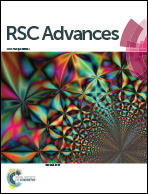Adjustable plasmonic optical properties of hollow gold nanospheres monolayers and LSPR-dependent surface-enhanced Raman scattering of hollow gold nanosphere/graphene oxide hybrids†
Abstract
Colloidal hollow gold nanospheres (HGNs) with adjustable localized surface plasmon resonance (LSPR) properties were synthesized and self-assembled into HGNs monolayers as a proper substrate for investigation of LSPR-dependent surface enhanced Raman scattering (SERS) behavior with Rhodamine B as the probe molecule. The SPR peaks of colloidal HGNs could be tunable over a wavelength region from 540 nm to 630 nm by carefully tailoring HGNs sizes and wall thicknesses. The broadening and red shift of SPR peaks of self-assembled HGNs monolayers were attributed to the electromagnetic coupling of adjacent HGN plasmons and the change of dielectric constant around HGNs when compared to those of colloidal HGNs. The relative SPR peak shift decayed nearly exponentially with the ratio of gap separation to diameter of HGNs, which fitted well with the “plasmon ruler” behavior of solid gold nanospheres and HGN dimeric reported previously. Our results indicated that the SERS performance of HGNs monolayers was highly LSPR-dependent and an obvious enhancement in the Raman signals was collected when the laser excitation line matched with the peak position of LSPR band of HGNs monolayers. Furthermore, the sandwich-structured HGN/graphene oxide/HGN (HGN/GO/HGN) hybrid was constructed through layer-by-layer method with spin-coated GO nanosheets as the interlayer. The cladding structures had better SERS activity than the HGNs monolayer due to the chemical enhancement of GO and coupled electromagnetic enhancement of double HGNs in the horizontal and vertical directions. The designed HGN/GO/HGN hybrid configuration with LSPR-dependent SERS performance exhibited a potential application in chemical sensors, environmental monitoring, disease controlling, and food safety fields.


 Please wait while we load your content...
Please wait while we load your content...